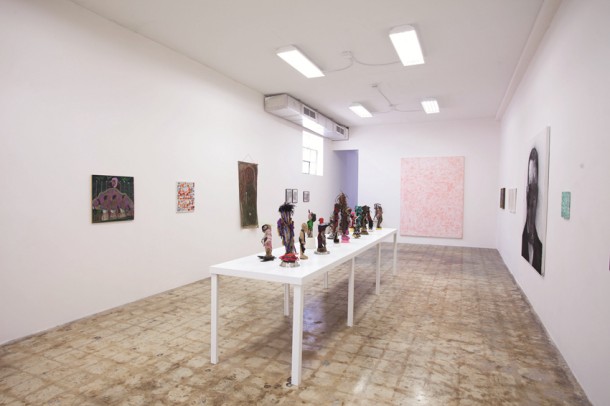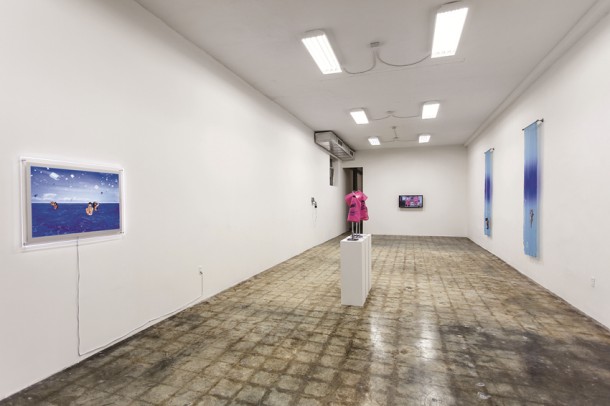GUCCIVUITTON
| January 21, 2015 | Post In LEAP 30
TO GET TO Guccivuitton, an artist-run commercial gallery whose programming blends contemporary art and south Florida vernacular, you head north-northeast about 16 kilometers from the Miami of the imagination to Little Haiti. Here are churches, roti shops, and botánicas selling everything an immigrant might need—from SIM cards to sacrificial chickens. That is, if you can see them through the thicket of “For Lease” signs.
Little Haiti is a relatively new neighborhood, even for a city as young as Miami. The neighborhood overlaps Little River and Lemon City (named after lemon groves wiped out by development sprawl and citrus canker outbreaks) and didn’t pick up the petite moniker until the mid-1980s, when it received large numbers of refugees fleeing the regime of president Jean-Claude “Baby Doc” Duvalier. For decades, it was among the poorest and most violent neighborhoods in the country, but it is now the latest target of south Florida’s rapacious appetite for gentrification.

In most places, artists have the privilege of ushering in such changes, studio lofts and art spaces often being the first harbingers of a coming landscape. It’s no different in Miami, with South Beach, Wynwood, and Downtown jumpstarted—completely or in part—by contemporary art. And it won’t be any different with Little Haiti.
When Guccivuitton opened in the spring of 2013, three local artists split the duties of painting walls and curating shows: Loriel Beltran, Aramis Gutierrez, and Domingo Castillo. Beltran, a recent immigrant from Venezuela, is known for several bodies of work reflecting on Miami’s cultural landscape, using the plaster columns and terrazzo countertops of middle class Miami to create monuments to the city’s fantastic domesticity. Gutierrez, also from Venezuela, is an exceptionally gifted painter who represents the world through a fictive mesh with an eye towards everything from Degas to Vegas. Castillo, who maintains a solo practice and programs with the collaborative the end/SPRING BREAK, creates spectacles—screening Werner Herzog’s Aguirre, Wrath of God on a yacht, for instance—that match the pageantry of the city.
All of these artists have lived in Miami for years, but have also spent time away from the city. They understand where and how Miami succeeds and fails. It falls short in its gallery scene. While the city has a great tradition of artist-run alternative spaces and non-profits, including Locust Projects and Dimensions Variable, there was never an artist-run commercial gallery. The mission is straightforward: present contemporary art that could be shown anywhere but should be shown in Miami, and present it in a clean, well-lighted space. This seems normal, almost conservative, but, in light of the dog and pony show that the city’s Wynwood gallery district has become, conservative is refreshing. With the name, however, things go left of center.
Miami is many things, but mainly a place to spend money and be an immigrant. Guccivuitton is the perfect name for a gallery in an immigrant community filled with shops boasting the latest in designer knock-offs—one of those rare places where art, curatorial insight, and external conditions add up. Along the way, the gallery keeps a reflexive eye on the social conditions surrounding the gallery: the neighbor factor.

Take the spring 2014 show “The Look,” titled after Charlotte Rampling, who starred in the 2005 film Heading South about female sex tourists in Haiti. In film and exhibition alike, there’s a lot to gaze upon: paintings in the emblematic Haitian style (rudimentary, the product of scavenged supplies, lack of formal education, a canny understanding of how the art—and artist—is perceived by the patronizing tourist class), wall-mounted metal sculptures, and, on a slender plinth that stretches the length of the gallery, a congregation of dolls made by an artist named Guyado. These idols are made out of wood, cloth, nails, ballpoint pens, bits of plastic, and appliances. Basically, whatever the artist had around. What- ever he could sell to the tourists.
In the evening, the white walls begin to speak in tongues, to chant and to sing. The gallery shares a wall with the Body of Christ Assembly Church. The sound is a great addition to the show; if drywall-muffled howls of worship don’t bring the art object back to its animist roots, nothing does. The gallery also has music in the evenings, inviting the community to dance to Haitian drummer Zamba Zao and Kris Rara, a band that normally plays neighborhood block parties. Call it programming. Call it outreach.
From the beginning, the gallery has used its programming to advance an aesthetic and social mission for art. The first exhibition feature art404, a pair of young net artists out of Miami. In what could be billed as the Erased de Kooning of the 4chan generation, the duo presents a live collaborative performance in which hackers associated with Anonymous take down the websites of Da- vid Zwirner, Gagosian, and other institutions.
The following exhibition is another surprise. “Florida Land- scape Painting” was a museum-quality exhibition tracing the origins of our visual understanding of Florida (palm trees, sunsets) through the work of African American painters who realized that they could make more money painting schlock for tourists than they could in the orange groves. The group, called the Highway- men, spent years perfecting an assembly line amongst themselves and then selling the resulting work to vacationers. The picaresque provenance of these works must be contextualized in the bitter in- justices of Jim Crow; while the primary goal was an easy buck, the effect was a group of marginalized Americans skillfully claiming and manipulating a portion of the country’s visual identity. For this exhibition, Highwaymen paintings from the 1950s to 80s were paired with contemporary artists painting the landscape, defining the complex web of racial and social history that the paintings— with a splash of seafoam and a swooping pelican—both represent and gloss over.

The exhibition “Cause Living Just Isn’t Enough” marks the first time Hugo Montoya has shown in years. Upon entering the space, the viewer first comes to a neon, spray-painted boulder weighing about 400 pounds, balancing on a single piece of steel rebar drilled into the floor. Montoya stole the boulder from a shooting range in Wynwood, a neighborhood once optimistically called a gallery district, but now mocked within the art community. Wynwood began about 15 years ago, when a few pioneering galleries moved in. As the neighborhood grew in tandem with the success of Art Basel Miami Beach, it became home to some of Miami’s greatest private collections: the Rubell Family Collection, the Margulies Collection, and the now-defunct World Class Boxing. It is now known for an outdoor museum of murals that resemble graffiti but lack its vigor, because most were commissioned by property developers.
It’s rare that running a commercial gallery is seen first and foremost as an altruistic gesture, but that’s what Guccivuitton has been to Miami. While it lasts, the space offers Miami a bit of introspection and, perhaps, cohesion. While the community is quite small, it is nonetheless divided between helicoptered-in art fair art and an uncritical devotion to local art-making. Guccivuitton uses each one to examine the other, almost always to the benefit of both.


